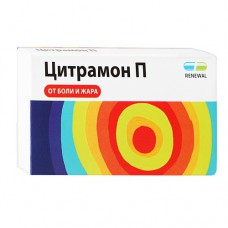Expiration date: 08/2026
Pharmacological action
Citramon P has analgesic, anti-inflammatory, analgesic that eliminates the symptoms of colds and flu, protivomigrenoznoe and stimulating effect.
Testimony
Pain mild and moderate symptoms (various origins): headache, migraine, toothache, neuralgia, myalgia, arthralgia, algomenorrhea. Feverish syndrome with colds and flu.
Method of application and doses
Inside (during or after eating), 1 tablet every 4 hours, when pain syndrome — 1-2 tablets; the average daily dose — 3-4 tablets, the maximum daily dose — 8 tablets. The course of treatment — 7-10 days.
The drug should not be taken more than 5 days as an analgesic drugs and more than 3 days and antipyretic (without assignment and supervision). Other dosages and patterns of use are established by the doctor.
Side effects
Gastralgia, nausea, vomiting, hepatotoxicity, nephrotoxicity, erosive and ulcerative lesions of the gastrointestinal tract, allergic reactions (including Stevens-Johnson syndrome, Lyell's), tachycardia, increased blood pressure, bronchospasm.
With prolonged use — dizziness, headache, blurred vision, tinnitus, decrease platelet aggregation, hypocoagulation, hemorrhagic syndrome (nosebleeds, bleeding gums, purpura, etc.), damage to the kidneys with papillary necrosis; deafness; Reye's syndrome in children (or hyperpyrexia, metabolic acidosis, abnormalities of the nervous system and psyche, vomiting, liver function abnormalities).
Contraindications
Hypersensitivity; erosive-ulcerative lesions of the gastrointestinal tract (exacerbation), gastrointestinal bleeding, bronchial asthma, urticaria or acute rhinitis, provoked by taking atsetilsalitsilovoj acid or other NSAIDs; hemophilia, hemorrhagic diathesis, hypoprothrombinemia, portal hypertension; vitamin K, kidney failure, pregnancy (I and III trimester), lactation; deficiency of glucose-6-phosphate dehydrogenase, severe hypertension, severe coronary heart disease, glaucoma, anxiety, sleep disorders; surgical intervention, accompanied by bleeding, children's age (under 15 years — the risk of Reye's syndrome in children with hyperthermia on a background of viral diseases).



